An Efficient and Economical Combination of Exploration Methods for Pb-Zn Polymetallic Skarn Deposits: A Case Study of the Periphery of Hetaoping Deposit, Yunnan Province, China
Abstract
:1. Introduction
2. Geological Setting
2.1. Regional Geological Setting
2.2. Geological Setting of Deposits
3. Data Acquisition and Processing
3.1. Aeromagnetic Survey
3.2. Geological, Geochemical, and Magnetic Surveys
3.3. Magnetic Susceptibility Measurement of Rocks
4. Results and Discussion
4.1. Determining Planar Locations of Ore Bodies through Magnetic, Geological, and Geochemical Surveys
4.1.1. Ground Magnetic Survey
4.1.2. Ground Geological Survey
4.1.3. Geochemical Survey of Soil Samples
4.2. Determining the Spatial Locations of Ore Bodies through Inversion of Aeromagnetic Data
4.3. Determining Deep Intrusion Space through 3D Inversion of Regional Gravity Data
4.4. Metallogenic Geological Process and the Building of a Prospecting Model
4.4.1. Analysis of the Metallogenic Process
4.4.2. Building of Prospecting Model
5. Conclusions
Author Contributions
Funding
Data Availability Statement
Acknowledgments
Conflicts of Interest
References
- Yang, Y.L.; Ye, L.; Cheng, Z.T.; Bao, T. Origin of fluids in the Hetaoping Pb–Zn deposit, Baoshan-Narong-Dongzhi block metallogenic belt, Yunnan Province, SW China. J. Asian Earth Sci. 2013, 73, 362–371. [Google Scholar] [CrossRef]
- Deng, J.; Wang, Q.F.; Li, G.J. Tectonic evolution, superimposed orogeny, and composite metallogenic system in China. Gondwana Res. 2017, 50, 216–266. [Google Scholar] [CrossRef]
- Goldfarb, R.J.; Qiu, K.F.; Deng, J.; Chen, Y.J.; Yang, L.Q. Orogenic gold deposits of China. SEG Spec. Publ. 2019, 22, 263–324. [Google Scholar] [CrossRef]
- Qiu, K.F.; Goldfarb, R.J.; Deng, J.; Yu, H.C.; Gou, Z.Y.; Ding, Z.J.; Wang, Z.K.; Li, D.P. Gold deposits of the Jiaodong Peninsula, eastern China. SEG Spec. Publ. 2020, 23, 753–773. [Google Scholar] [CrossRef]
- Fu, D.G.; Cui, Z.L.; Guan, D.R. The comprehensive ore-prospecting of Jinchanghe blind multimetallic deposit, Baoshan. Yunnan Geol. 2004, 23, 188–198, (In Chinese with English Abstract). [Google Scholar]
- Wang, J.Y.; Yang, C.H.; Fu, J.; Zhang, W.W.; Xie, J.; Li, J.B. Metallogenic models andprospecting criteria for the Jinchanghe Au–Cu polymetallic ore–concentration area in western Yunnan. Geol. Explor. 2021, 57, 0254–0268. [Google Scholar] [CrossRef]
- Chen, Y.Q.; Lu, Y.X.; Xia, Q.L.; Jiang, C.X.; Liu, H.G.; Lü, Z.C. Geochemical characteristics of the Hetaoping Pb- Zn deposit, Baoshan, Yunnan, and its genetic model and ore prospecting model pattern. Geol. China 2005, 32, 90–99, (In Chinese with English Abstract). [Google Scholar]
- Chen, F.C.; Deng, J.; Wang, Q.F.; Huizenga, J.M.; Li, G.J.; Gu, Y.W. LA-ICP-MS trace element analysis of magnetite and pyrite from the Hetaoping Fe-Zn-Pb skarn deposit in Baoshan block, SW China: Implications for ore-forming processes. Ore Geol. Rev. 2020, 117, 103309. [Google Scholar] [CrossRef]
- Zhao, Z.X.; Wu, Z.Q. The metallogenetic rule and target seeking of Dachangao multimetal deposit in Baoshan. Yunnan Geol. 2008, 27, 338–343, (In Chinese with English Abstract). [Google Scholar]
- Ma, Y.L.; Zou, R.R.; Wang, J.Y. Heiniuwa Au deposit of alteration rock type of fracture zone in Baoshan, Yunnan. Yunnan Geol. 2014, 33, 22–27, (In Chinese with English Abstract). [Google Scholar]
- Shchukina, E.V.; Shchukin, V.S. Diamond Exploration Potential of the Northern East European Platform. Minerals 2018, 8, 189. [Google Scholar] [CrossRef] [Green Version]
- Ge, T.F.; Qiu, L.; He, J.Z.; Fan, Z.G.; Huang, X.Z.; Xiong, S.Q. Aeromagnetic identification and modeling of mafic-ultramafic complexes in the Huangshan-Turaergen Ni-Cu metallogenic belt in NW China: Magmatic and metallogenic implications. Ore Geol. Rev. 2020, 127, 103849. [Google Scholar] [CrossRef]
- Zhang, J.; Zeng, Z.; Zhao, X.; Li, J.; Zhou, Y.; Gong, M. Deep Mineral Exploration of the Jinchuan Cu–Ni Sulfide Deposit Based on Aeromagnetic, Gravity, and CSAMT Methods. Minerals 2020, 10, 168. [Google Scholar] [CrossRef] [Green Version]
- Lu, N.; Liao, G.; Xi, Y.; Zheng, H.; Ben, F.; Ding, Z.; Du, L. Application of Airborne Magnetic Survey in Deep Iron Ore Prospecting—A Case Study of Jinling Area in Shandong Province, China. Minerals 2021, 11, 1041. [Google Scholar] [CrossRef]
- Ejiga, E.G.; Ismail, N.E.H.; Yusoff, I. Implementing Digital Edge Enhancers on Improved High-Resolution Aeromagnetic Signals for Structural-Depth Analysis around the Middle Benue Trough, Nigeria. Minerals 2021, 11, 1247. [Google Scholar] [CrossRef]
- Kim, B.; Jeong, S.; Bang, E.; Shin, S.; Cho, S. Investigation of Iron Ore Mineral Distribution Using Aero-Magnetic Exploration Techniques: Case Study at Pocheon, Korea. Minerals 2021, 11, 665. [Google Scholar] [CrossRef]
- He, J.Z.; Huang, X.Z.; Ge, T.F.; Fan, Z.G.; Dai, D.L.; Wang, S.X. Prospecting progress of aeromagnetic anomalies in the periphery of the Hetaoping Pb–Zn deposit, Baoshan, Yunnan Province. Geophys. Geochem. Explor. 2018, 42, 1201–1208, (In Chinese with English Abstract). [Google Scholar] [CrossRef]
- Zhu, Y.Y.; Han, R.S.; Xue, C.D.; Lu, S.L.; Zou, H.J.; Yuan, Z.H. Geological character of the Hetaoping lead zinc deposit of Baoshan, Yunnan province. Mineral Resour. Geol. 2006, 1, 32–35, (In Chinese with English Abstract). [Google Scholar]
- Chen, F.C.; Deng, J.; Shu, Q.H.; Li, G.J.; Cui, X.L.; Zhao, F.; Wang, Q.F. Geology, fluid inclusion and stable isotopes (O, S) of the Hetaoping distal skarn Zn–Pb deposit, northern Baoshan block, SW China. Ore Geol. Rev. 2017, 90, 913–927. [Google Scholar] [CrossRef]
- Xue, C.D.; Han, R.S.; Yang, H.L.; Yang, Z.M.; Tian, S.H.; Liu, Y.Q.; Hao, B.W. Isotope geochemical evidence for ore-forming fluid resources in Hetaoping Pb–Zn deposit, Baoshan, northwestern Yunnan. Miner. Depos. 2008, 7, 243–252, (In Chinese with English Abstract). [Google Scholar]
- Wang, Q.F.; Deng, J.; Li, C.S.; Li, G.J.; Yu, L.; Qiao, L. The boundary between the Simao and Yangtze blocks and their locations in Gondwana and Rodinia: Constraints from detrital and inherited zircons. Gondwana Res. 2014, 26, 438–448. [Google Scholar] [CrossRef]
- Tao, Y.; Hu, R.Z.; Zhu, F.L.; Ma, Y.S.; Ye, L.; Cheng, Z.T. Ore-forming age and the geodynamic background of the Hetaoping lead-zinc deposit in Baoshan, Yunnan. Acta Petrol. Sin. 2010, 26, 1760–1772, (In Chinese with English Abstract). [Google Scholar]
- Chen, W.T.; Zhou, M.F.; Gao, J.F.; Hu, R. Geochemistry of magnetite from Proterozoic Fe-Cu deposits in the Kangdian metallogenic province, SW China. Miner. Depos. 2015, 50, 795–809. [Google Scholar] [CrossRef]
- Chen, F.C.; Deng, J.; Wang, Q.F.; Li, G.J.; Shu, Q.H.; Yang, C.H.; Liu, J.Y.; Xu, R. The source and evolution of ore fluids in the Heiniuwa gold deposit, Baoshan block, Sanjiang region: Constraints from sulfide trace element, fluid inclusion and stable isotope studies. Ore Geol. Rev. 2018, 95, 725–745. [Google Scholar] [CrossRef]
- Metcalfe, I. Tectonic framework and Phanerozoic evolution of Sundaland. Gondwana Res. 2011, 19, 3–21. [Google Scholar] [CrossRef]
- Li, G.J.; Wang, Q.F.; Huang, Y.H.; Chen, F.C.; Dong, P. Discovery of Hadean–Mesoarchean crustal materials in the northern Sibumasu block and its significance for Gondwana reconstruction. Precambrian Res. 2015, 271, 118–137. [Google Scholar] [CrossRef]
- Xu, R.; Deng, M.G.; Li, W.C.; Lai, C.K.; Zaw, K.; Gao, Z.W.; Chen, Y.H.; Niu, C.H.; Liang, G. Origin of the giant Luziyuan Zn-Pb-Fe(-Cu) distal skarn deposit, Baoshan block, SE Tibet: Constraints from Pb–Sr isotopes, calcite C–O isotopes, trace elements and Sm–Nd dating. J. Asian Earth Sci. 2021, 205, 104587. [Google Scholar] [CrossRef]
- Liao, S.Y.; Wang, D.B.; Tang, Y.; Yin, F.G.; Cao, S.N.; Wang, L.Q.; Wang, B.D.; Sun, Z.M. Late Paleozoic Woniusi basaltic province from Sibumasu terrane: Implications for the breakup of eastern Gondwana’s northern margin. Geol. Soc. Am. Bull. 2015, 127, 1313–1330. [Google Scholar] [CrossRef]
- Wang, Q.F.; Deng, J.; Li, G.J.; Liu, J.Y.; Li, C.S.; Ripley, E.M. Geochronological, Petrological, and Geochemical Studies of the Daxueshan Magmatic Ni-Cu Sulfide Deposit in the Tethyan Orogenic Belt, Southwest China. Econ. Geol. 2018, 113, 1307–1332. [Google Scholar] [CrossRef] [Green Version]
- Yu, L.; Wang, Q.F.; Li, G.J.; Gao, L. Geochemistry, zircon U-Pb geochronology of granitic pegmatites from Caojian area in the northern Baoshan block, and their geological significance. Acta Petrol. Sin. 2015, 31, 3281–3296, (In Chinese with English Abstract). [Google Scholar]
- Deng, J.; Wang, Q.F.; Li, G.J.; Li, C.S.; Wang, C.M. Tethys tectonic evolution and its bearing on the distribution of important mineral deposits in the Sanjiang region, SW China. Gondwana Res. 2014, 26, 419–437. [Google Scholar] [CrossRef]
- Metcalfe, I. Gondwana dispersion and Asian accretion: Tectonic and palaeogeographic evolution of eastern Tethys. J. Asian Earth Sci. 2013, 66, 1–33. [Google Scholar] [CrossRef]
- Deng, J.; Wang, Q.F.; Li, G.J.; Santosh, M. Cenozoic tectono-magmatic and metallogenic processes in the Sanjiang region, southwestern China. Earth-Sci. Rev. 2014, 138, 268–299. [Google Scholar] [CrossRef]
- Deng, X.Z.; Tao, Y.; Li, J.; Xiong, F. Isotope and fluid inclusion geochemistry of the Cangyuan Pb-Zn-Ag polymetallic deposit in Yunnan. SW China. Ore Geol. Rev. 2017, 90, 928–942. [Google Scholar] [CrossRef]
- Wang, J.R.; Xue, C.D.; Huang, H.Y.; Jin, J.J. REE geochemical characteristics of Hetaoping Pb-Zn deposit, Baoshan county, western Yunnan province and its genetic implications. Geoscience 2014, 28, 721–730, (In Chinese with English Abstract). [Google Scholar]
- Jiang, L.Y. The new cognition of metallogenesis characteristics of Hetaoping Pb-Zn multimetallic deposit in Baoshan. Yunnan Geol. 2011, 30, 38–41, (In Chinese with English Abstract). [Google Scholar]
- Cui, Z.L.; Li, F.G.; Zhao, Z.X. Geological Survey of Hetaoping Mining Area in Wayao Town, Baoshan City, Yunnan Province; Fourth Geological Brigade of Yunnan Bureau of Geology and Mineral Resources: Baoshan, China, 1993; pp. 20–65. (In Chinese) [Google Scholar]
- Guan, Z.N. Geomagnetic Field and Magnetic Exploration; Geological Publishing House: Beijing, China, 2005; pp. 77–83. (In Chinese) [Google Scholar]
- Yang, X.W.; Guan, D.R. The comprehensive application of Geophys. Geochem. Explor. to Hetaoping ore deposit, Baoshan. Yunnan Geol. 2011, 30, 78–82, (In Chinese with English Abstract). [Google Scholar]
- Li, Y.; Oldenburg, D.W. 3-D inversion of magnetic data. Geophysics 1996, 61, 394–408. [Google Scholar] [CrossRef]
- Li, Y.; Oldenburg, D.W. 3-D inversion of gravity data. Geophysics 1998, 63, 109–119. [Google Scholar] [CrossRef]
- Goldfarb, R.J.; Mao, J.W.; Qiu, K.F.; Goryachev, N. The great Yanshanian metallogenic event of eastern Asia: Consequences from one hundred million years of plate margin geodynamics. Gondwana Res. 2021, 100, 223–250. [Google Scholar] [CrossRef]
- Einaudi, M.T.; Burt, D.M. Introduction; terminology, classification, and composition of skarn deposits. Econ. Geol. 1982, 77, 745–754. [Google Scholar] [CrossRef]
- Meinert, L.D. Skarns and skarn deposits. Geosci. Can. 1992, 19, 145–162. [Google Scholar]
- Meinert, L.D.; Dipple, G.M.; Nicolescu, S. World skarn deposits. In Economic Geology 100th Anniversary Volume, 1905–2005; Hedenquist, J.W., Thompson, J.F.H., Goldfarb, R.J., Richards, J.P., Eds.; Society of Economic Geologists Inc.: Littleton, CO, USA, 2005; pp. 299–336. [Google Scholar] [CrossRef]
- Vezzoni, S.; Dini, A.; Rocchi, S. Reverse telescoping in a distal skarn system (Campiglia Marittima, Italy). Ore Geol. Rev. 2016, 77, 176–193. [Google Scholar] [CrossRef]
- Zhao, Y.M.; Dong, Y.G.; Li, D.X.; Bi, C.S. Geology, mineralogy, geochemistry, and zonation of the Bajiazi dolostone-hosted Zn–Pb–Ag skarn deposit, Liaoning Province, China. Ore Geol. Rev. 2003, 23, 153–182. [Google Scholar] [CrossRef]
- Xu, R.; Li, W.C.; Deng, M.G.; Zhou, J.X.; Ren, T.; Yu, H.J. Genesis of the superlarge Luziyuan Zn-Pb-Fe(-Cu) distal skarn deposit in western Yunnan (SW China): Insights from ore geology and C-H-O-S isotopes. Ore Geol. Rev. 2019, 107, 944–959. [Google Scholar] [CrossRef]
- Xu, R.; Chen, W.; Deng, M.G.; Li, W.C.; Chen, F.C.; Lai, C.K.; Sha, J.Z.; Jia, Z.; Liu, W. Geology and C-O-S-Pb isotopes of the Fangyangshan Cu-Pb-Zn deposit in the Baoshan block (SW China) Implications for metal source and ore genesis. Ore Geol. Rev. 2021, 132, 103992. [Google Scholar] [CrossRef]
- Qiu, K.F.; Yu, H.C.; Deng, J.; McIntire, D.; Gou, Z.Y.; Geng, J.Z.; Chang, Z.S.; Zhu, R.; Li, K.N.; Goldfarb, R.J. The giant Zaozigou orogenic Au-Sb deposit in West Qinling, China: Magmatic or metamorphic origin? Miner. Deposita 2020, 55, 345–362. [Google Scholar] [CrossRef]
- Qiu, K.F.; Yu, H.C.; Hetherington, C.; Huang, Y.Q.; Yang, T.; Deng, J. Tourmaline composition and boron isotope signature as a tracer of magmatic-hydrothermal processes. Am. Mineral. 2021, 106, 1033–1044. [Google Scholar] [CrossRef]
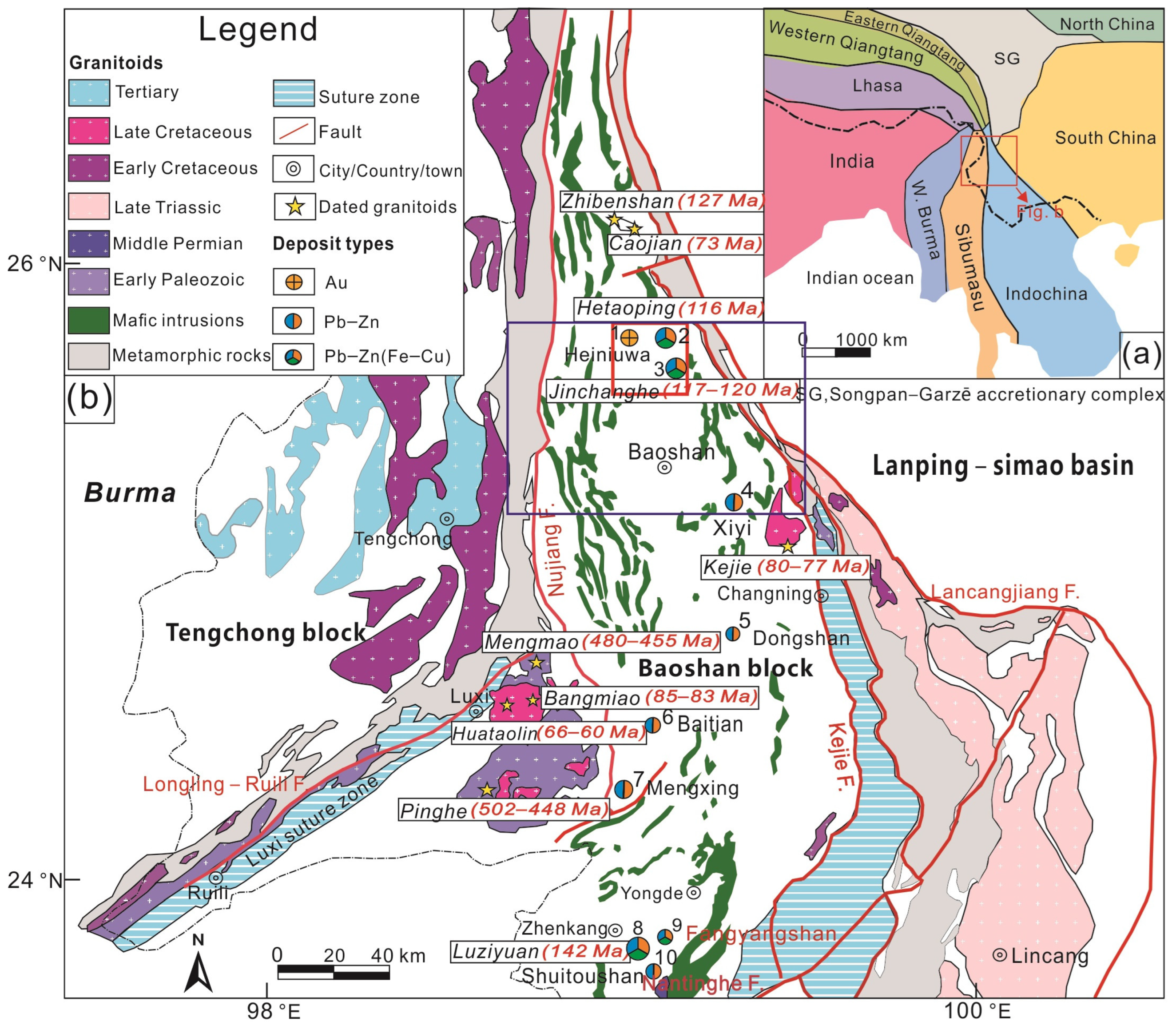
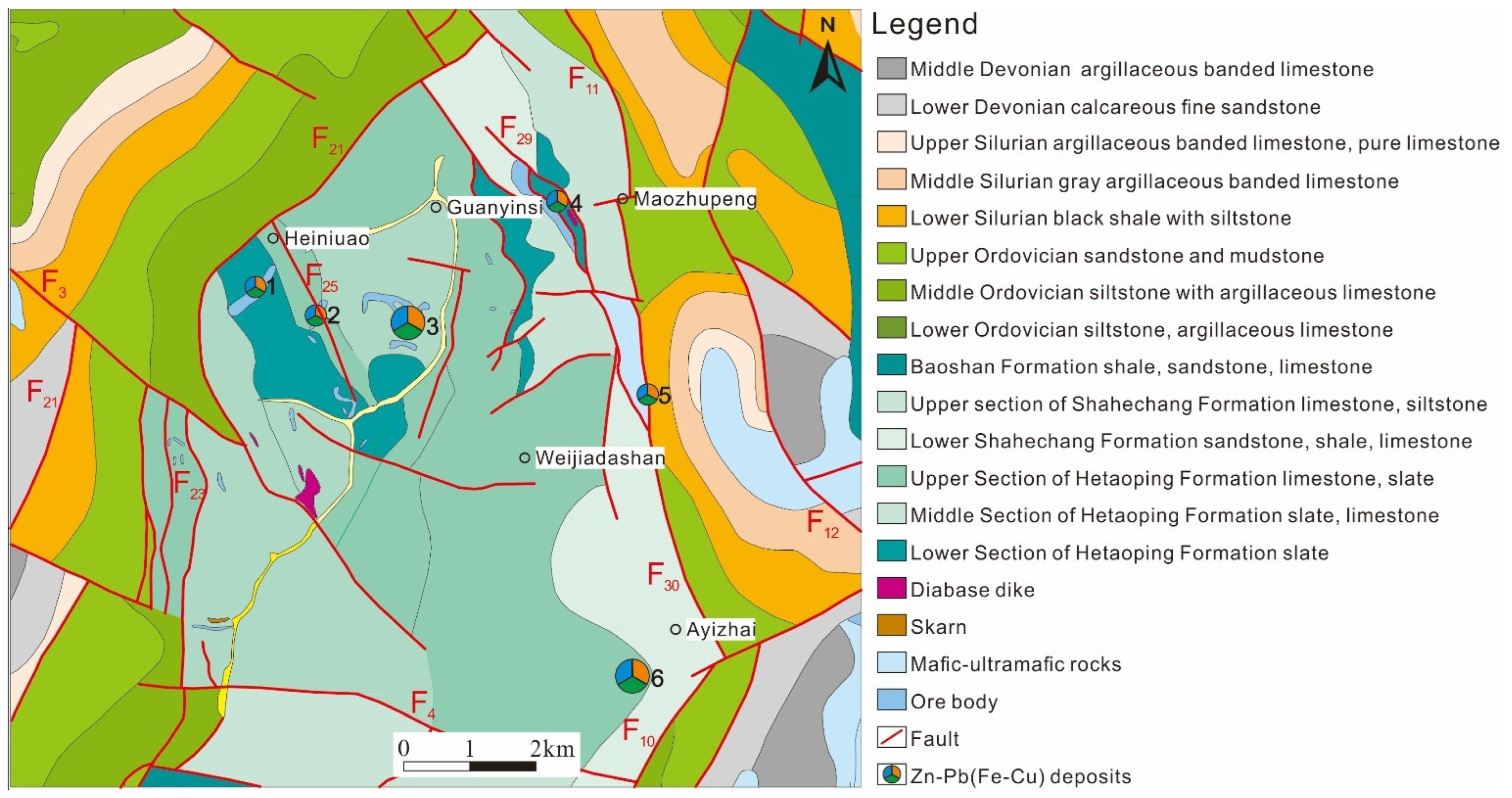
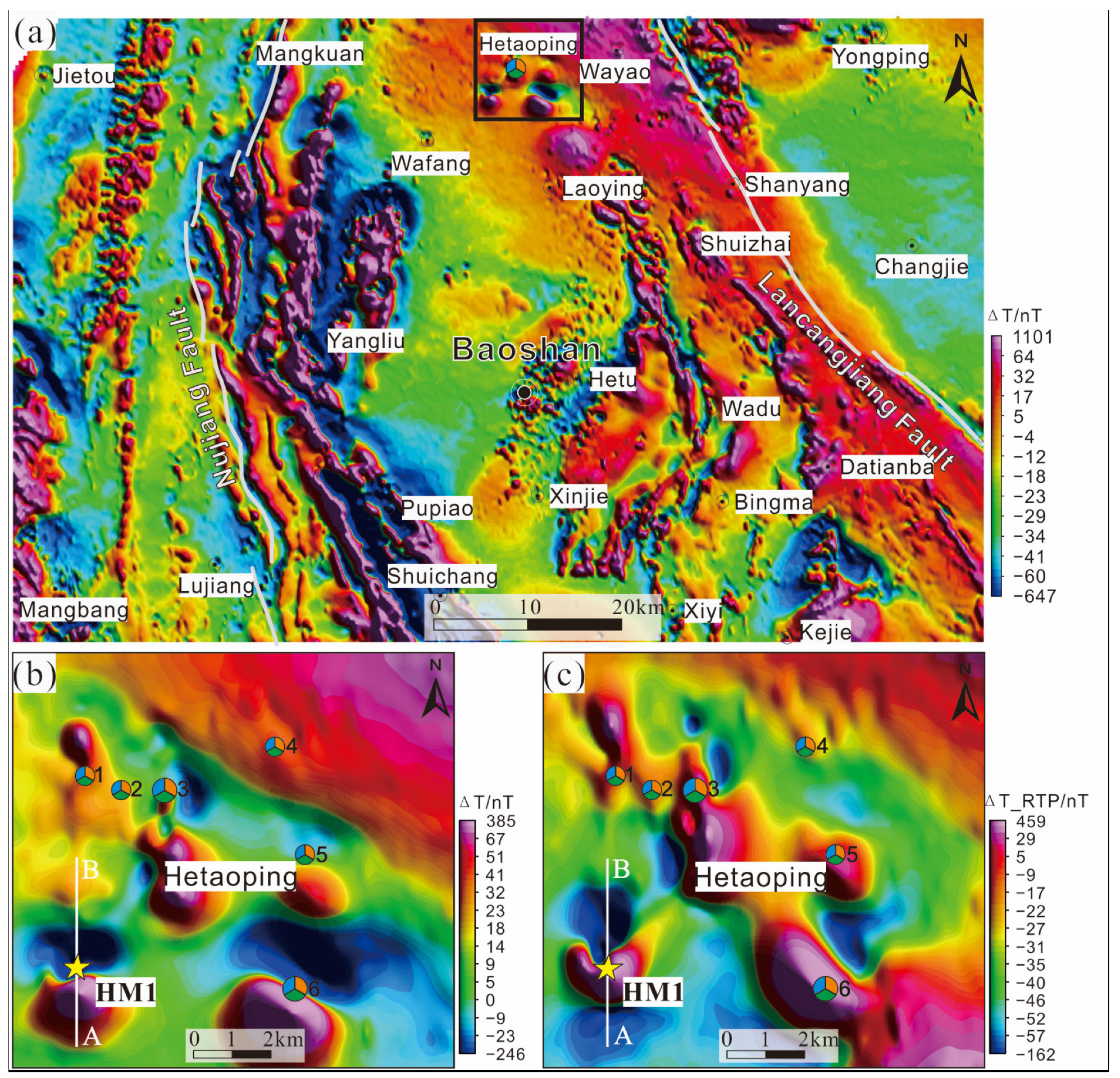
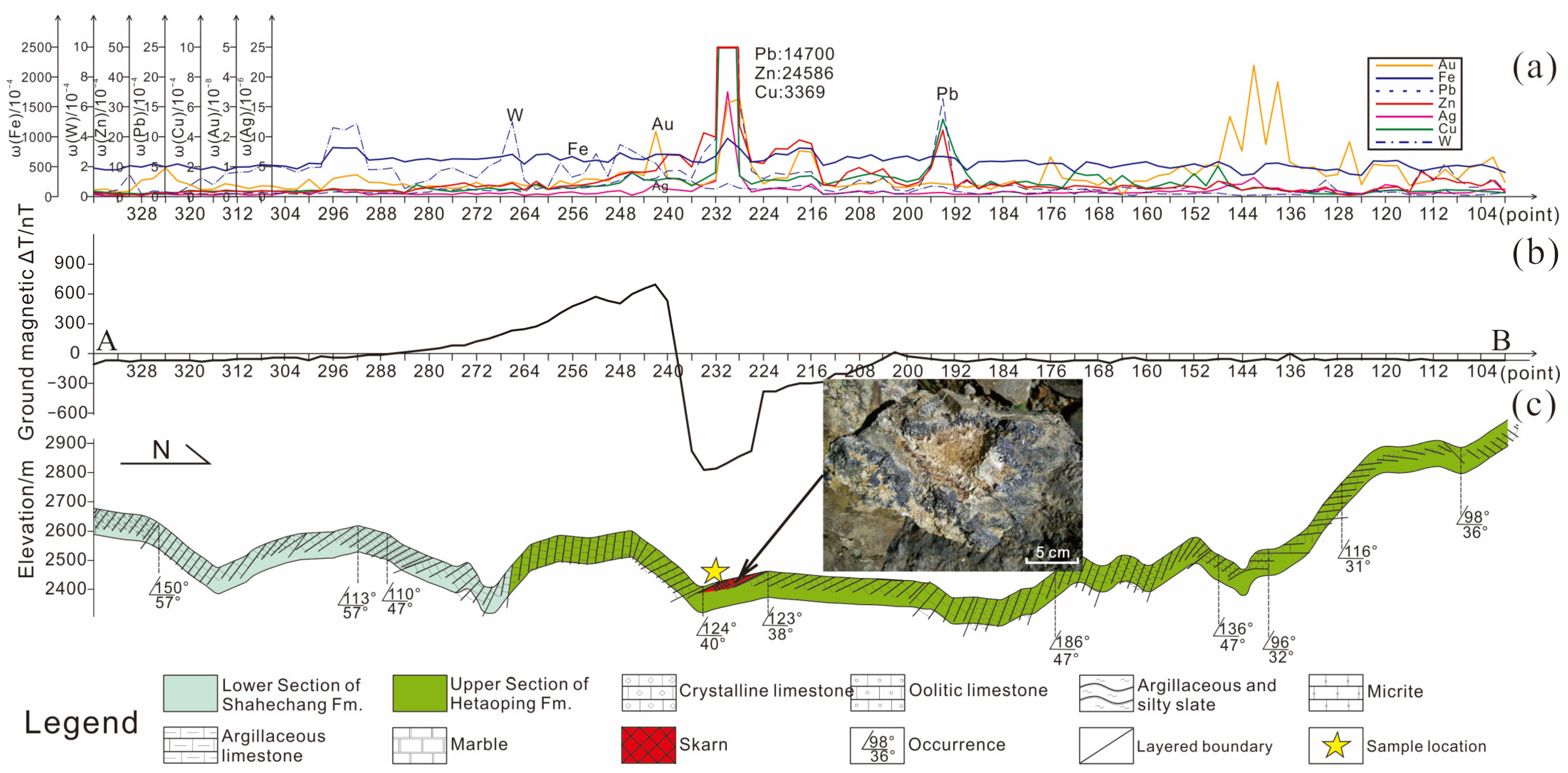
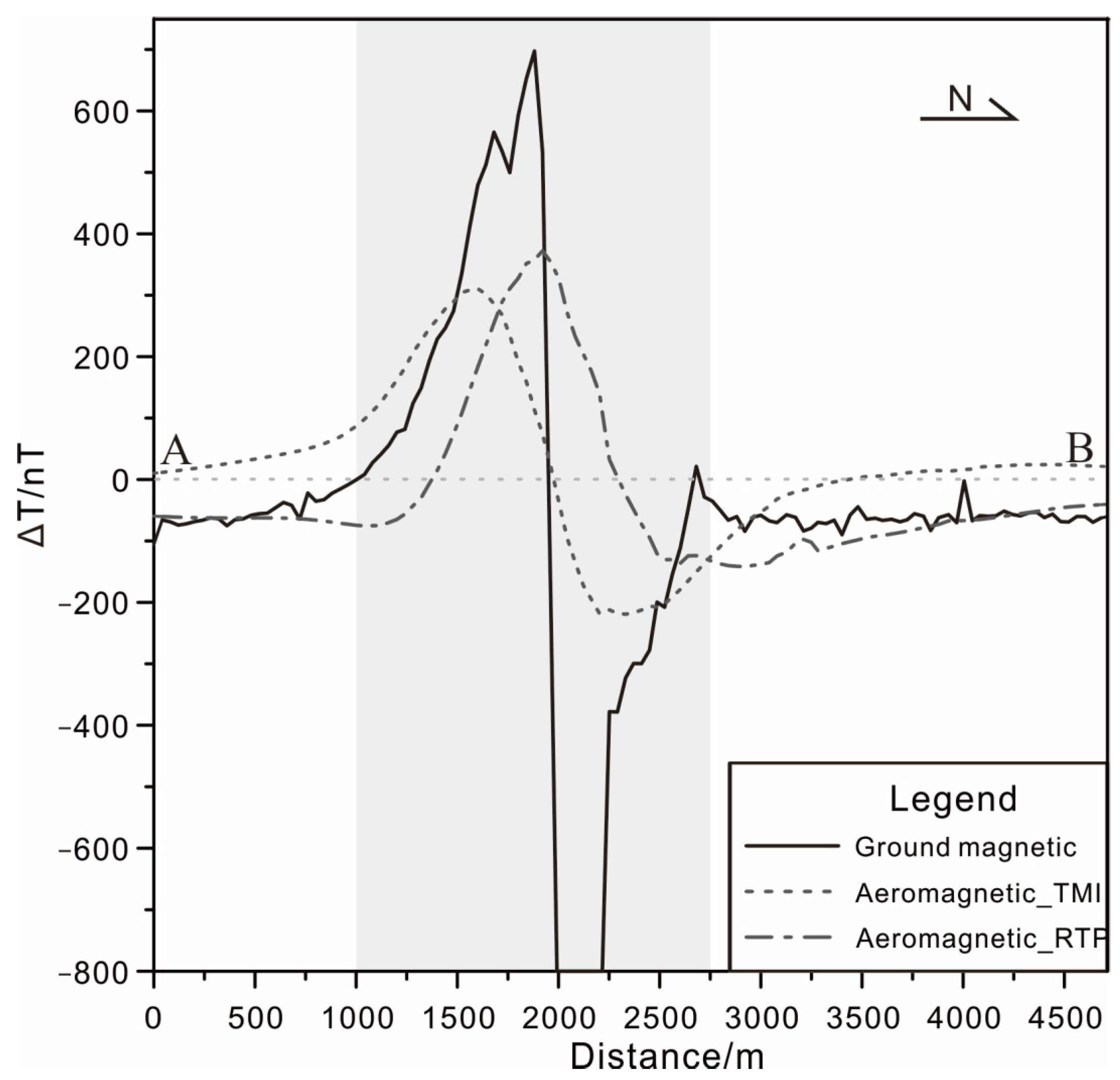

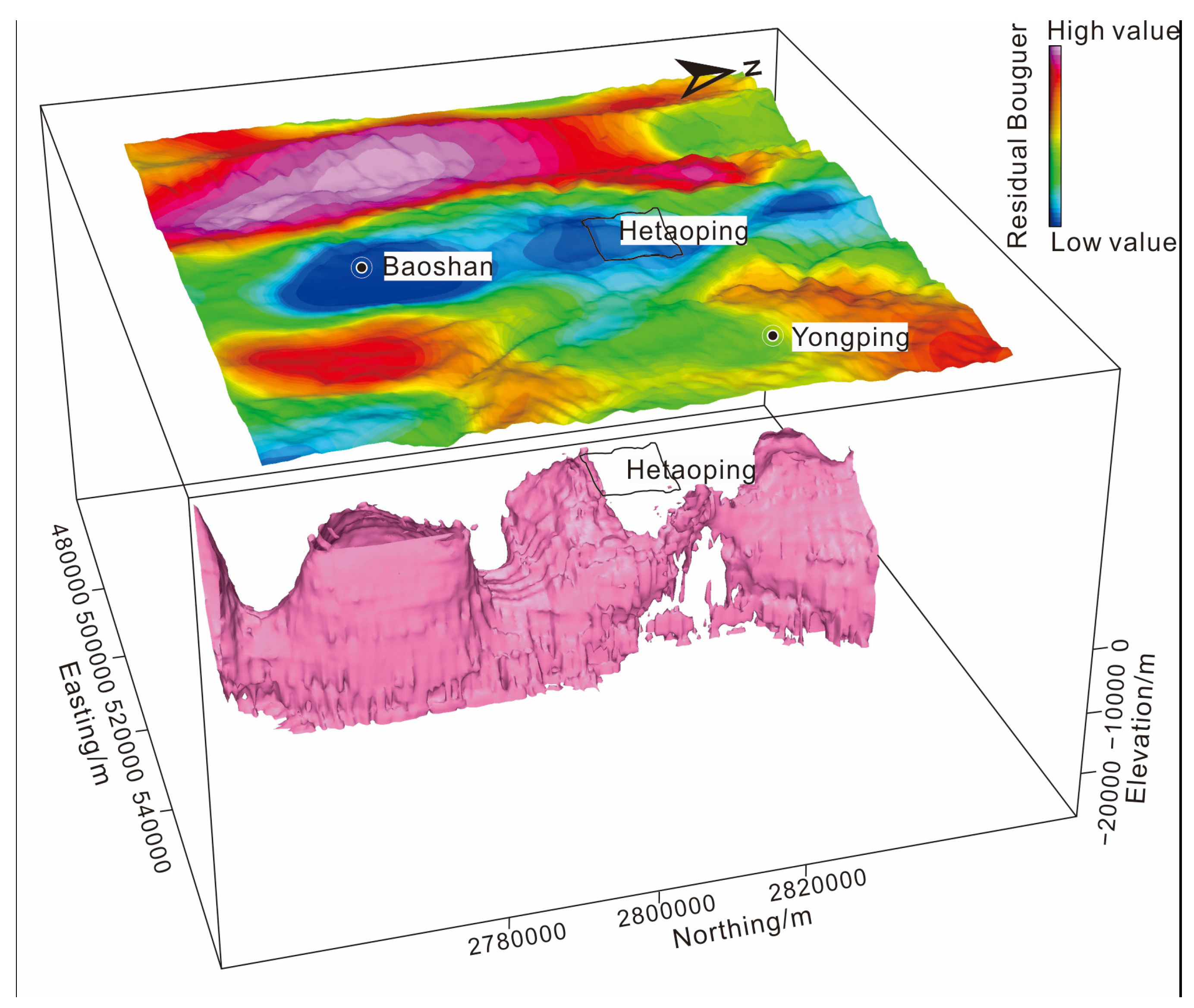
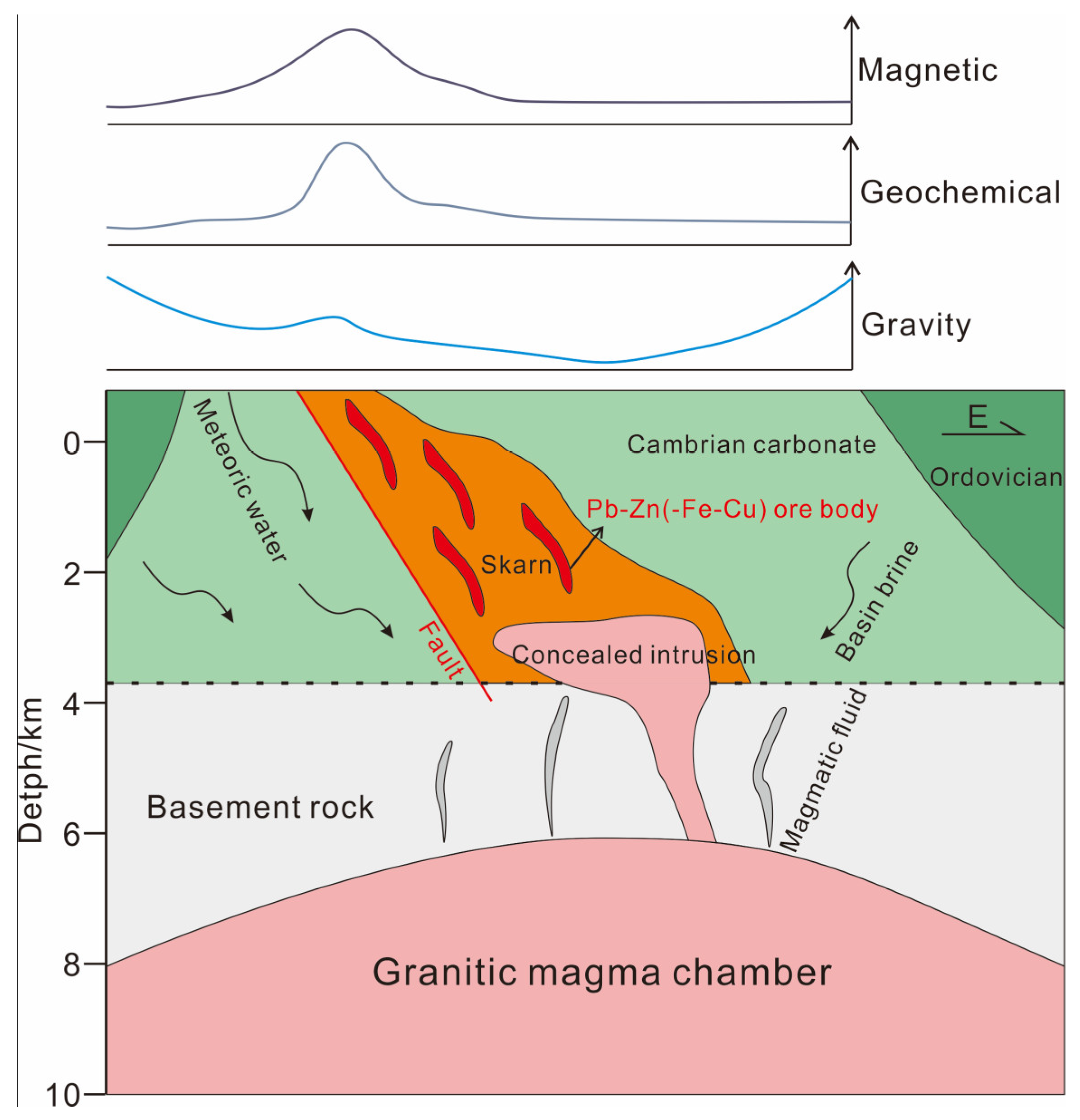
| Au (ppm) | Ag (ppm) | Cu (wt%) | Pb (wt%) | Zn (wt%) | Ni (wt%) | Hg (ppm) |
| 0.69 × 10−6 | 18.7 × 10−6 | 0.42 × 10−2 | 1.68 × 10−2 | 3.64 × 10−2 | <0.002 × 10−2 | 0.58 × 10−6 |
| TFe (wt%) | Mo (wt%) | Sn (wt%) | W (wt%) | As (ppm) | Sb (ppm) | |
| 19.14 × 10−2 | <0.002 × 10−2 | <0.002 × 10−2 | 0.034 × 10−2 | 1278 × 10−6 | 42.1 × 10−6 |
| Lithology | Sample Quantity | Susceptibility | Remanent Magnetization Intensity Jr/(10−3A/m) | ||
|---|---|---|---|---|---|
| Range | Average | Range | Average | ||
| Siltstones, silicified and pyritized fine sandstones | 13 | 0.2–266 | 221 | 0.1–231 | 100 |
| Mudstones, argillaceous siltstones | 15 | 0.2–271 | 62 | 0.1–236 | 8 |
| Limestones, finely crystalline limestones, marls | 17 | 239–339 | 91 | 5–34 | 13 |
| Calcareous and silty slates, marbleized limestones | 12 | 30–256 | 118 | 6–63 | 19 |
| Cataclasites, quartz veins | 4 | 63–312 | 199 | 20–108 | 57 |
| General mafic rocks | 15 | 20–113 | 72 | 5–111 | 22 |
| Diabases | 4 | 138–1090 | 477 | 11–869 | 249 |
| Pyritized magnetized mafic rocks | 4 | 7803–52,258 | 24,792 | 3512–24,349 | 18,046 |
| Ultramafic rocks | 3 | 61,325–442,103 | 21,7454 | 194,188–560,809 | 338,357 |
| Pb-Zn ores (bearing pyrite, limonite, and chalcopyrite) | 8 | 49–153 | 86 | 7–91 | 58 |
| Pb-Zn ores (bearing specularite and pyrite) | 7 | 3596–545 | 453 | 54–100 | 75 |
| Pb-Zn ores (bearing magnetite and pyrrhotite) | 6 | 3166–62,476 | 40,533 | 1539–136,516 | 61,055 |
| Pb-Zn ores in adits (bearing magnetite and pyrite) | 8 | 143,868–1,426,537 | 785,802 | 119,390–448,215 | 283,803 |
| Skarns | 9 | 66–16,381 | 3737 | 9–10,291 | 2073 |
| Granites | 6 | 15–1540 | 400 | 5–1310 | 178 |
Publisher’s Note: MDPI stays neutral with regard to jurisdictional claims in published maps and institutional affiliations. |
© 2022 by the authors. Licensee MDPI, Basel, Switzerland. This article is an open access article distributed under the terms and conditions of the Creative Commons Attribution (CC BY) license (https://creativecommons.org/licenses/by/4.0/).
Share and Cite
He, J.; Ge, T.; Tan, H.; Huang, X.; Xiong, S.; Fan, Z.; Dai, D. An Efficient and Economical Combination of Exploration Methods for Pb-Zn Polymetallic Skarn Deposits: A Case Study of the Periphery of Hetaoping Deposit, Yunnan Province, China. Minerals 2022, 12, 749. https://doi.org/10.3390/min12060749
He J, Ge T, Tan H, Huang X, Xiong S, Fan Z, Dai D. An Efficient and Economical Combination of Exploration Methods for Pb-Zn Polymetallic Skarn Deposits: A Case Study of the Periphery of Hetaoping Deposit, Yunnan Province, China. Minerals. 2022; 12(6):749. https://doi.org/10.3390/min12060749
Chicago/Turabian StyleHe, Jingzi, Tengfei Ge, Hongjie Tan, Xuzhao Huang, Shengqing Xiong, Zhengguo Fan, and Dalong Dai. 2022. "An Efficient and Economical Combination of Exploration Methods for Pb-Zn Polymetallic Skarn Deposits: A Case Study of the Periphery of Hetaoping Deposit, Yunnan Province, China" Minerals 12, no. 6: 749. https://doi.org/10.3390/min12060749
APA StyleHe, J., Ge, T., Tan, H., Huang, X., Xiong, S., Fan, Z., & Dai, D. (2022). An Efficient and Economical Combination of Exploration Methods for Pb-Zn Polymetallic Skarn Deposits: A Case Study of the Periphery of Hetaoping Deposit, Yunnan Province, China. Minerals, 12(6), 749. https://doi.org/10.3390/min12060749






